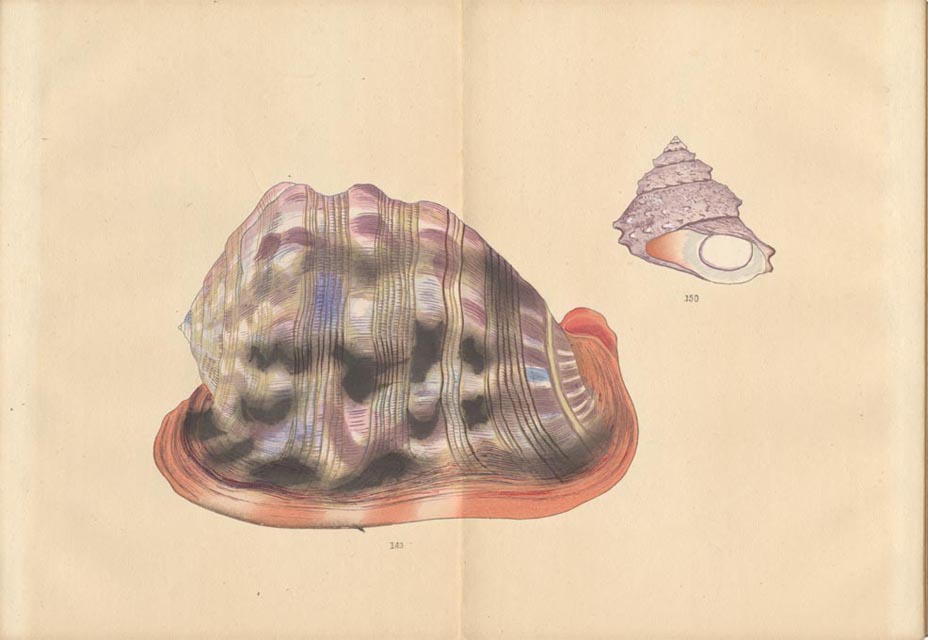
Hirase Yoichiro and his Woodblock Publications
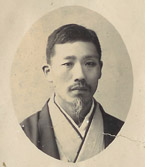
Hirase Yoichiro (1859-1925) was a collector, dealer and scholar of Malacology active in Kyoto at the beginning of 20th century.
Hirase began his collection of shells around 1898 and in 1907 published the first issue of the “Conchological Magazine”. In 1913 he opened a museum devoted to shells in the Okazaki area near the Kyoto zoo. Hirase became internationally well-known for his discoveries of new shells, his scientific publications and for selling shells to collectors and museums in Europe and the United States.
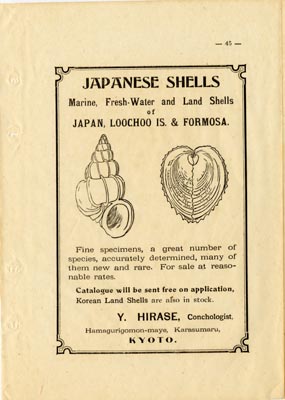
The Hirase's advertising in The Official Catalogue. Kyoto Commercial Museum. 1910.
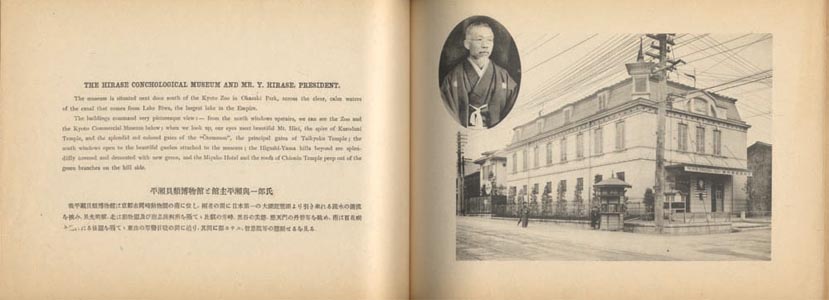
Hirase's portrait and the Hirase Conchological Museum's building illustrated in the Museum's handbook. 1915.
A shell pattern book
Among his many scientific publications, Hirase published two woodblock print books through the leading Kyoto art publisher Unsodo. The first one, the single-volume Kaigara Danmen Zuan, in traditional Japanese binding, is dated in the colophon Taisho 2 (1913) and, except for two fine colour plates following the preface, is illustrated in black and white with over 50 pages of designs based on the cross sections of 12 different shells. According Jennifer Cohlman Bracchi from the Cooper Hewitt Museum of New York, in the two pages preface Hirase explains “that he is not a designer or artist, but that he came up with the idea for this book while researching shells and cutting them at various angles. He found the cross sections so strange and interesting that he used seal ink to stamp them on paper. These “inside wonders” created interesting patterns which he further explored with illustrator Jun Nishikawa”.
Kaigara denmen zuan was presented in the publisher’s catalogue, as a “design book” (Unsodo no. 652). It is interesting to note on the cover the title followed by the number ichi (one). Probably Hirase was planning a sequel for this book but no other volume are known with this title and format.
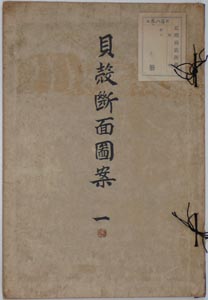
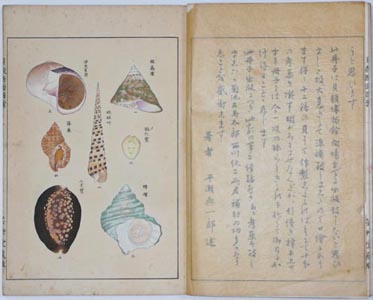
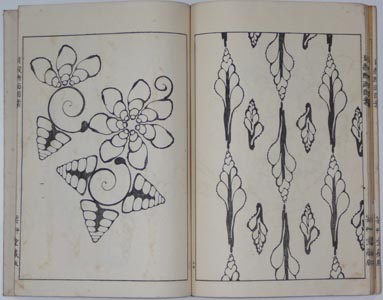
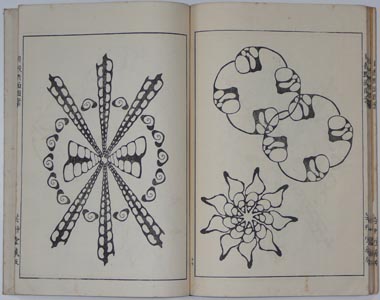
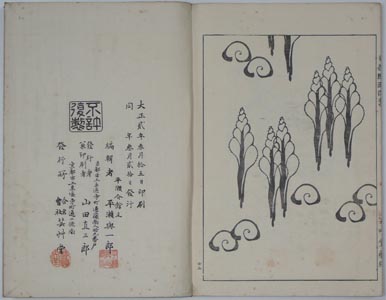
The "Kaigara Danmen Zuan". One volume. Kyoto, Unsodo, 1913. The cover, illustrations and colophon.
An ambitious publication
One year later Hirase published with Unsodo his second woodblock publication. A much more ambitious set of books titled Kai senshu (One Thousand Kinds of Shells) or Kai Chigusa.
The format of these books are this time in accordion album size (orihon) with orange silk covers with title slips in the middle. All the plates were in colour and the shells were depicted in an accurate, realistic way. Ten volumes were probably planned, to illustrate 1000 shells as announced in the title, but due to later financial restraints only four volumes appeared. The first one was published in 1914, the second and third in 1915 and the fourth in 1922. Each volume shows 100 shells illustrated on twenty plates.
In the English preface to the second volume of Kai senshu, Hirase explains the reason he chose the old traditional woodblock printing process, “a peculiar art of our country”, instead of modern colour lithography or three-color printing.
He further proposed his book as "...being not wholly for the benefit of scientific studies but rather for the purpose of reference for artists and technologists.."
This publication was also introduced in the publisher’s catalogue as “for designers’ companion” (Unsodo no. 653 with title Kai Sen Shu).
It is clear that both author and publisher were interested in reaching a wider audience outside Japan and beyond the shell collectors audience, the use of woodblock printing, particularly appreciated in the West, was an additional merit for their publications.
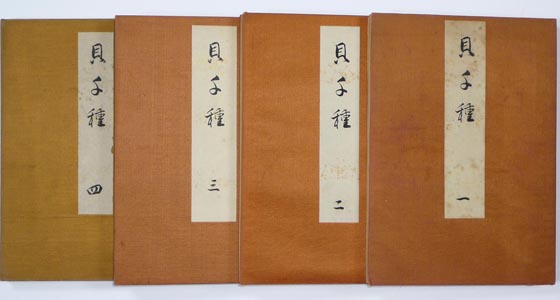
The "Kai senshu". Four volumes. Kyoto, Unsodo, 1914-15-22.
The press run of Kai senshu
The exact number of printings and copies produced of Kai senshu is known.
This is of special interest for anyone interested in Japanese woodblock books and gives an insight into the production terms of the publisher Unsodo.
In the article “Dates of publication of Yoichiro Hirase’s Kai Chigusa” by Paul Callomon of the Academy of Natural Sciences of Philadelphia, the author reproduces a detailed list of all printings and dates of publication obtained from Unsodo by an American scientist, Alvin R. Cahn, in 1957.
The press run and dates can be summarized as follows:
First volume: eight printings from 1914 to 1937 and a total of 880 copies.
Second volume: six printings from 1915 to 1935 and 750 copies.
Third volume: five printings from 1915 to 1933 and 650 copies.
Fourth volume: three printings from 1922 to 1935 and 400 copies.
The press run varies from 300 copies for the first printing of all four volumes to 100, 50 and 30 copies for later printings.
The 30 copies made in 1935 and 1937 seem to be a very small production runs, but even if they were not done on commission, it was probably still profitable for Unsodo to do a kind of “print-on–demand” publishing.
Literature:
Paul Callomon, Dates of publication of Yoichiro Hirase’s Kai Chigusa in The Nautilus 118, p. 175-176, 2004.
Paul Callomon and Akira Tada, Yoichiro Hirase and his role in Japanese Malacology in Bulletin of the Nishinomiya Shell Museum no. 4. Nishinomiya 2006.
Yamada Unsodo Co., An Illustrated Catalogue of Books, Periodicals & Albums for Art & Artistic Designs. Kyoto 1915.
Web-resources:
http://www.cooperhewitt.org/2013/05/29/inside-wonders-a-japanese-pattern-book/
Designed & Written by Lella & Gianni Morra © 2011-Present (All Rights Reserved)
